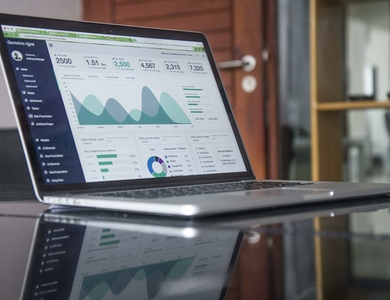
The State Of Data-Driven Marketing In 2023
In this article, we will take a look at the state of data-driven marketing in 2023 and how it is transforming the marketing landscape.
Read MoreAt [B]RIGHT, we illuminate data-informed digital solutions to help your brand succeed in an increasingly complex marketing landscape. Which means we help brands grow based on data, research, and a hefty dose of proven processes, tactics, and channel-specific strategies.
We take the guesswork out of your marketing strategy.
Marketing teams are often manually pulling together audience, sales, social, and other data sources from silos in an attempt to bring about personalized marketing for customers and to formulate their overarching strategies. Manual curation can be time-consuming and expensive. This comes as no surprise, as enterprise level marketing teams use 52 marketing tools on average, according to Snowflake, a data cloud solutions company. Snowflake has put together a few pointers on ways to best align your organization and data sources for max impact, creating a truly data-driven organization.
Start by aligning marketing departments and IT departments. (A decision will have to be made on a platform where almost all the company’s data should be housed for cross-departmental access.) The database should be minable by any department by implementing a no-code solution to reduce barriers to usage, and the IT people should be appreciative that some of their time has been freed up. A unified database should help in answering marketing questions to facilitate momentum and data-driven decision-making (e.g., bringing together point-of-sales data with merchandising-performance insights to determine the best product to be featured in a timely advertising campaign and the demographics for best targeting the ads). Having that sort of horsepower behind decision-making is a surefire way to be intentional with company resources and to produce results. It all comes down to a company-wide trusted source of data that is secure, concise, easily used, and shared between teams.
Search Engine Journal has assembled a list of four tactics for implementing an effective Google Ads campaign by diving deep on campaign settings and configuration:
Globally, 91 percent of people prefer when brands are funny and the World Happiness Report found that 90 percent of people are more likely to remember a funny advertisement. This propensity toward humor comes as no surprise, considering the last few years with the pandemic. Research done by Oracle also reported that consumers are seeking experiences that make them feel happiness, offsetting increased stress levels.
Consumer preferences are signaling an appetite for humor, but according to reports, only 20 percent of brands use humor in offline ads and only 18 percent report using humor in digital ads. That small support of humor from businesses is coming from only 5 percent of executives, as 95 percent of business leaders fear using humor in consumer engagements, according to Oracle studies.
Where does your brand stand on humor? If executed well, in a brand-authentic way, it can certainly be received well by consumers, but if executed poorly can open a PR and community-management nightmare. There is no exact right or wrong method, but this is a strategy that should not be taken lightly, should align with your brand’s identity, should be scrutinized from various consumer perspectives before implementing, and should match your audiences’ preferences. After all, not everyone will appreciate a 10-year-old’s sense of humor.
Duncan Webb, the president of Webb Management Services Inc., a major consultant to many performing arts organizations, came to the realization that arts organizations have access to a wealth of data but they don’t know how to use it. This epiphany came to him after a visit to the LA Dodgers “War Room,” a data-intelligence conference room equipped with monitors for viewing, in addition to player stats, their venue’s customer-purchase data.
Ticketmaster, the nationally known ticketing system, is employed by many arts organizations and theater houses. And while Ticketmaster, and other such platforms, has improved its sophistication and abilities over the years, arts organizations have failed to utilize these data gold mines. Why? Often, according to Webb, it’s due to the lack of funding to employ the necessary staff to mine these databases.
Aubrey Bergauer, an arts industry analytics advocate, said that there are many ways that both small and large arts operations can implement low-cost data-driven decision-making: “Every organization, no matter how big or small, has access to its own online database. It’s a resource that is often underutilized beginning with the data you get for free from Google Analytics (which measures website performance). Facebook, Twitter, and Instagram all have built-in analytics tools.”
The solution, Bergauer emphasizes in her seminars, is learning to ask the right questions: “We want to test a project and define what is going to make it successful, then go seek the analytics that will answer that question.” A statement that rings true for arts organizations and that is applicable to any operation.
Resonate, an audience research and syndicated data company, has provided their take on where consumers are in 2022, identifying three key groupings to represent this. One is the Overwhelmed Consumer, which has clearly been exacerbated by the uncertainty caused by the pandemic; this segment was characterized primarily by parents who are juggling the day-to-day of work and childcare demands. The second segment is the Influenced Consumer, which is highly swayed in purchasing decisions by social ads and influencers, particularly in regard to cosmetics and clothing. Lastly, Resonate identified the Activist Consumer. This grouping prioritizes corporate responsibility, and its members are willing to pay for products supporting various causes. Let’s take a deeper look at each audience segment.
The Overwhelmed Consumer is 158 percent more likely than the average consumer to indicate they’re planning on buying a bar cabinet. They’re also 45 percent more likely to buy alcohol online and 57 percent more likely to say drinking at home increased during the pandemic. This segment, on the flip side, is likely to turn to uplifting, pleasing products and experiences that offer a reprieve from the fatigue of ongoing uncertainty. They are likely to purchase products that are family friendly, fun, exciting, or innovative, and they’re also more likely to be in the market currently for home-improvement products, major appliances, toys, craft supplies, or sports and fitness equipment than the other segments.
The Influenced Consumer is 50 percent more likely to have accent chairs on their wish list, and 70 percent more likely to have their eyes on ottomans. According to Resonate, this segment is more likely to be starting families, pursuing online education, or helping a family member into a retirement community than the other segments. Home-goods companies should be scaling up influencer marketing if they are not already, as members of this segment are 59 percent more likely to consider social media influencers as an influential source of information in their apparel purchases. However when considering purchases, four out of five cite best prices as their number one retailer selection trait.
The Activist Consumer is 80 percent more likely to shop from DTC brands that ship directly to them—from a brand’s website, primarily. They focus on corporate responsibility, but that does not mean they are opposed to large corporations. The Activist Consumer is more likely than other consumers to have an Amazon Prime membership, Costco membership, Instacart, and others. This group is 151 percent more likely to shop at women- or minority-owned stores. According to Resonate, they may be more likely than the other segments to be experiencing life events such as looking for new jobs, adopting pets, starting a small business, or having a teen driver at home.
Where do these groups stand on brand loyalty? According to the research, the Influenced Consumer is the most likely to sway to new brands. (Considering price is a high factor and reliance on influencer input this is no surprise.) The Overwhelmed and Activist Consumers are much less likely to change brands, the Overwhelmed Consumer has less time to evaluate a brand change and the Activist Consumer is more likely to stick to their already vetted philanthropic, socially responsible product choice
(Editorial) Methodology: We help brands grow based on data, research, data analysis and synthesis, and a hefty dose of proven processes, tactics, and channel-specific strategies. | Objective: To distribute timely insights and information about tools, trends, and research and data strategies that work. | Sample size: n=the entirety of the Internet. | Audience: Smart brand marketers that understand the importance of using data and research to inform strategic decision-making.

In this article, we will take a look at the state of data-driven marketing in 2023 and how it is transforming the marketing landscape.
Read More
Marketers need to be agile and proactive in their planning, adapting to the changing landscape and staying ahead of the competition.
Read More
The marketing landscape in 2022 saw the continuation of several key trends, including the growing importance of data-driven marketing, the rise of e-commerce and the increasing dominance of digital channels.
Read More